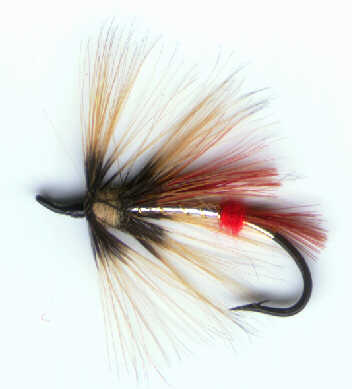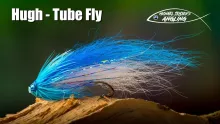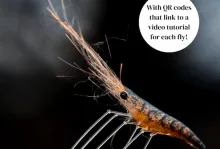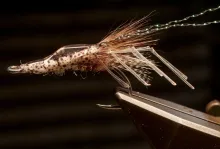I have been experimenting a bit with stream patterns for sea trout. One of the results has been a larger and more salmon fly like version of the Umbrella - a salt water fly that I have used with good success.

I have been experimenting a bit with stream patterns for sea trout. One of the results has been a larger and more salmon fly like version of the Umbrella - a salt water fly that I have used with good success.
The larger version still has the hallmarks of the salt water fly: tail and wing from golden phesant body feathers and a double hackle, but also has a tag and a butt.
| Hook | 6-2 Bartleet salmon fly hook |
| Thread | Black |
| Tag | Narrow flat silver tinsel |
| Butt | Red wool |
| Tail | Red golden phesant body feather |
| Body | Flat silver tinsel |
| Rib | Oval gold tinsel |
| Wing | Red golden phesat body feather |
| Hackle | Two furnace or badger hen hackles separated by a small ball of opossum dubbing |
| Head | Black |

- Cover the hook shank with a smooth layer of thread. Let the thread hang down to reach the hook point
- Tie in a strip of narrow silver tinsel and wind it to reach a point above the point of the barb and back
- Tie down and cut surplus
- Remove the webby barbs on a red golden phesant body feather. Only the barbs of almost equal length should be left.
- Tie in the feather as a tail, curve down, tip reaching a point above the curve of the hook
- Cut surplus
- Cover the base of the tail and tag with a small tuft of red wool
- Tie in the ribbing under the hook shank
- Wind the thread in touching turns to the return point of the eye
- Tie in flat silver tinsel and wind in smooth, touching turns to the butt and back (see detailed instructions for ribbed tinsel body)
- Tie down and cut surplus
- Wind the rib in five open turns to the front of the silver body and tie off under the hook shank
- Tie in a large furnace hackle, tip first and shiny side out (see detailed instructions for classic hackle)
- Wind clockwise to form the rear hackle. 2-3 turns will suffice
- Tie down and cut surplus
- Dub a rather large and webby lump of opossum in front of the first hackle, leaving room for the second hackle and the head
- Tie in and wind the second hackle as the first
- Form a rather small head, whip finish and varnish
- Log in to post comments







